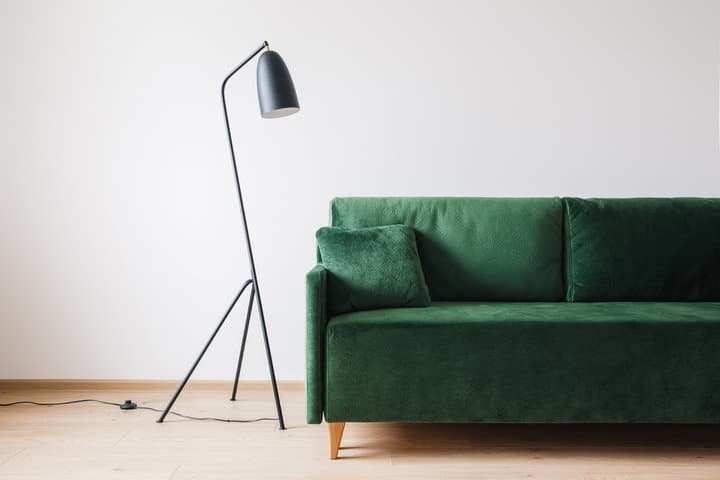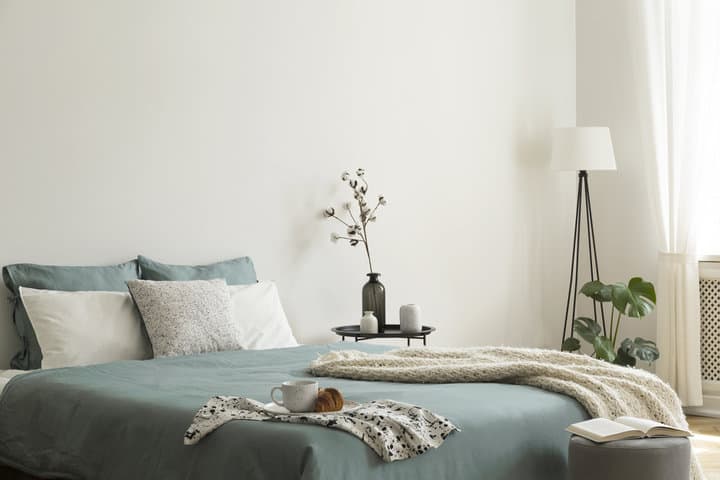Effectively lighting a room is a delicate task. If you don’t light the room sufficiently, you could end up with shadowy areas that don’t look pleasant or even hide a hazard.
But overlight the room, adding too many lights, and it will be too bright. Your room won’t be relaxing, and it’ll feel clinical and uncomfortable.
Floor lamps are a good way of lighting a room, but how do you know where to place them to get the right effect, and how many should you use?
Floor lamps offer flexible lighting and have different positions for their purpose. The best place is usually near you – either near the sofa or the bed – as this provides ambient and task lighting. You can use multiple floor lamps if they are for ambient lighting and are far enough apart to justify the amount of light.
There’s no single right answer on where to place a floor lamp, so let’s take a look at:
- How to light a living room with floor lamps
- Where to place a floor lamp in a bedroom
- Whether two floor lamps in a room is a good idea
How To Light A Living Room With Floor Lamps?

One of the best things about floor lamps is their versatility.
They are tall enough to provide ambient lighting for a room and suitable for task lighting if positioned correctly.
You can even use them for accent lighting, depending on the features in your room.
This gives you a lot of options for a living room. However, most floor lamps are designed to be positioned next to *something*.
It may not matter what that thing is, but from a design perspective, floor lamps generally don’t look great when floating in the middle of a space along a wall.
So you have three main positions for a floor lamp in a room:
- In a corner
- Alongside a piece of furniture
- Behind a piece of furniture
Here’s a look at some potential places you could put a floor lamp in a living room:
In The Corner
Floor lamps work well in the corner of a room if you want to provide ambient lighting, as they reflect light off both adjacent walls.
You lose the shadows that the corner would typically house and instead create a warmer, softer space.
Behind The TV
Placing a lamp behind a TV, especially if your TV is in the corner of a room at an angle, means you get a lovely accent for the TV setup and the benefit of the light without any glare on the screen.
Next To A Desk
Floor lamps can be used for task lighting too.
If your living room has a desk, use a floor lamp to provide enough light for you to work without taking up space on the desk itself, as a table lamp would.
Alongside A Fireplace
Placing a floor lamp alongside a fireplace means you can create warm lighting from multiple sources, especially if your fireplace protrudes.
The heating source will provide gentle forward-facing light while the lamp covers the receded corner.
For that reason, and because symmetry in design always works well, a floor lamp on either side of a fireplace is a good idea.
Positioning A Floor Light Next To A Couch

Placing a floor lamp near a couch or sofa is a good way of providing ambient lighting and task lighting for those times when you’re reading a book or just having a meal on your lap while watching TV.
If the couch is against the wall, place the lamp to the side, so it is near the sofa without overhanging it – you don’t want it to feel claustrophobic.
If your couch is floating in the room away from the wall, place the lamp behind it if there’s a suitable space.
It’ll be less invasive when watching TV since the light is outside your field of vision, but it’ll still provide the ambient lighting you need to warm the space.
How Tall Should The Floor Lamp Be?
You want a floor lamp to be tall enough that the lampshade is not below your eye level when sitting down.
It can be at eye level for ambient lighting, but slightly higher is better for both ambient and task lighting.
Therefore, your floor lamp should likely be between 58 and 64 inches tall. Measure where your eye level is before you buy, and aim for a lamp that’s a little taller.
Placing Floor Lamps In A Bedroom

There are fewer options for placing a floor lamp in a typical bedroom, although if you have a larger room, your options open up a little.
For most people, the primary place to put a floor lamp in a bedroom would be alongside the bed, tucked behind a side table.
It’d replace a table lamp if you want to keep your side table clear for other accessories.
If you have a larger room, a floor lamp near a wardrobe or a desk also serves as a good way of lighting up the space.
Can I Have Two Floor Lamps In One Room?

You can have two floor lamps in a single room, provided the space is large enough to comfortably accommodate them.
Floor lamps may look minimal, but they are still a prominent feature in a room, and you want to keep the space manageable.
It’s important to keep floor lamps far enough apart that they aren’t competing. Otherwise, you won’t get the right balance of light in the room.
If the light overlaps, you’ll create spaces that are too bright and look washed out.
Having floor lamps in separate corners or symmetrical recesses (on either side of a protruding fireplace) offers a good balance of light and design.
It’s also essential to have your floor lamps at a similar height.
Ideally, you’d buy two of the same light, but if you prefer your style to be more eclectic, they still need to be either the same height or within an inch.
If they are at different heights, you’ll get different planes of light in the room, and the competing light will look strange.
In terms of a maximum number, a good rule of thumb is to have four light sources in a typical living room, though you might not use them all at once.
You may have a primary light fixture in the ceiling for general lighting. Then two floor or table lamps can provide a softer light in the evening.
Add accent lighting for a primary feature, such as a bookcase or fireplace, and create a well-lit but aesthetically pleasing ambiance.
If you forego the ceiling fixture, you may want to consider a third lamp, but three floor lamps may take up too much space – two floor lamps and a table lamp would probably be a better balance.
Final Words
You can get quite creative with your choice of a floor lamp, and to some extent with the location, but you obviously want to avoid having it as an eyesore, especially as you’ll want to hide the lamp’s wires as well.
In a living room, you’ll generally have more options for positioning, while bedrooms tend to be more limited.
Remember that the key rules are to decide on the purpose of the light – ambient only, or task and ambient – and to ensure it’s at a suitable height, just above eye level when you’re sat down.
Have you ever had any design headaches when adding a floor lamp to your room?
Looking for an LED bulb but not sure what type you need?
Check out my free bulb picker and select the right bulb within few clicks.

